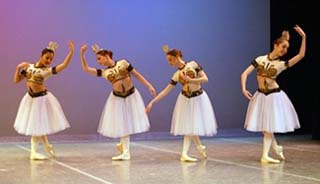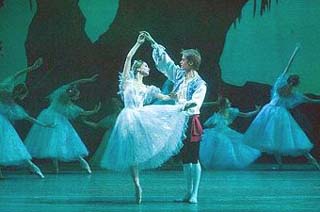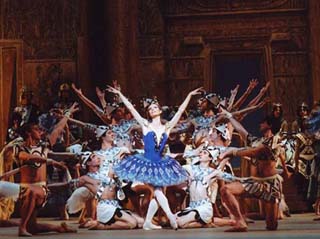
Students of the Universal Ballet Academy
in the Waltz of the Animated Frescoes
from the Pugni/Saint-Léon/Petipa
The Little Humpbacked Horse , Washington D.C., 2005
It is only in Russia that one can see a performance of any of Pugni's full-length ballets that have either survived through time to the present day, or that have been revived after many years of absence from the stage.
Of the full-length works that have withstood the test of time, there is only The Little Humpbacked Horse and La Esmeralda . The Little Humpbacked Horse left the active repertory of the Kirov/Mariinsky Ballet (the former Imperial Ballet) long ago, and today the work is only presented in its full-length form by the Vaganova Academy of Russian Ballet (school of the Kirov/Mariinsky Ballet), occasionally given with the top graduates of a school year in the lead roles. Petipa revived The Little Humpbacked Horse for the first and last time in 1895 (under the title The Tsar Maiden ), with the great Ballerina Pierina Legnani as the Tsar Maiden. Since then the ballet has been kept alive by many different Balletmasters, teachers, and choreographers, among them - Alexander Gorsky , Pyotr Gusev , Agrippina Vaganova , Natalia Dudinskaya , Konstantin Sergeyev , and Ninel Kurgapkina . Today the ballet is light-years away from the opulent spectacle that it once was, with Pugni's score heavily weighed down with additional music from many different composers. Musically and Choreographically only fragments of Pugni, Saint-Léon, and Petipa's text remain, giving one a tiny glimpse at what was once this glorious ballet.
La Esmeralda is given in modern times in a more authentic staging both choreographically and musically, by way of the Mussorgsky Ballet 's 1981 revival. This production was mounted by Nicolai Boyarchikov , director of the Mussorgsky Ballet, and Tatiana Vecheslova , former Prima Ballerina of the Kirov/Mariinsky Ballet. Vaganova mounted a revival of La Esmeralda with Vecheslova in the lead in 1931. Prior to this Vecheslova had danced in Petipa's last revival of the ballet (for Mathilde Kschessinskaya in 1898), which was retained in the Kirov/Mariinsky Ballet's repertory until 1928. The Mussorgsky Ballet director Boyarchikov decided to mount a revival of La Esmeralda as it was danced before Vaganova's version, which Vecheslova still remembered. Vecheslova restored many of the scenes and dances which had become either lost or altered over time, including Mathilde Kschessinskaya's original Pas de Deux written especially for her by Riccardo Drigo in 1898 (known in modern times as the La Esmeralda Pas de Deux ), and the elaborate Grand Pas Classique from Act II danced by Fleur-de-Lys, Captain Phoebus, 3 female soloists, and the Corps de Ballet . For this production Pugni's score, with additions by Drigo dating from 1886 and 1898, was restored with the aid of a repètitèur used by the Imperial Ballet before the turn of the 20th century. Today this production is still in the active repertory of the Mussorgsky Ballet, and was recently filmed and released onto DVD, though unfortunately the near 3-hour production was edited for the filming, trimming it down to a little over 55 minutes.
Regarding modern revivals, Arthur Saint-Léon's 1844 Pas de Six from the ballet La Vivandière (AKA Markitenka , as it is known in Russia) was reconstructed in 1975 by the dance notation expert Ann Hutchinson-Guest and Pierre Lacotte for the Joffrey Ballet from Saint-Léon's own original choreographic notation, which included the original orchestral parts for Pugni's music. In 1978 the Balletmaster Pierre Lacotte staged the work for the Kirov/Mariinsky Ballet, who still maintain it in their repertory. Today this reconstructed Pas de Six is given by many companies throughout the world.
In 2000 Lacotte mounted a revival of the 1862 Pugni/Petipa ballet The Pharaoh's Daughter , last performed in 1928, for the Bolshoi Ballet , though unfortunately he was refused access to Pugni's original score, preserved in the archives of the Mariinsky Theatre, and Lacotte was forced to piece together the music from various sources, with the Bolshoi Theatre conductor Alexander Sotnikov serving as orchestrator. In 2006 Lacotte mounted a revival of the original production of the 1843 Pugni/Perrot ballet Ondine (AKA The Naiad and the Fisherman ) for the Kirov/Mariinsky Ballet. Both works were choreographed by Lacotte "in the style of the epoch", with The Pharaoh's Daughter containing only 4 dances from Petipa 's own staging, a few of which were reconstructed from the Stepanov Choreographic Notation from the Sergeyev Collection .
In the west (primarily in North America ) the average balletomane will likely only ever encounter Pugni's Pas de Quatre (revived by Anton Dolin in 1941), originally staged by Perrot in 1845 at Her Majesty's Theatre, which is the most performed work of all of Pugni's output, though the music is presented in a reorchestration by Leighton Lucas , as the original manuscript was destroyed when Her Majesty's Theatre burned down in 1867. The original piano reduction of Pas de Quatre is housed in the National Library of France, which includes Pugni's original orchestral parts for the Variation of Mme. Cerrito , the only part of the complete score to have survived.
Aside from Pas de Quatre , western balletomanes may encounter Pugni's additional music for the ballet Le Corsaire , as has been staged in recent years in the United States by American Ballet Theatre and the Boston Ballet - the Variation of Gulnare , usually interpolated into the scene Le Jardin Animé , or his extended version of Adolphe Adam 's Pas des Odalisques , for which he added the first, and second variations and coda for Petipa's revival of 1863.
Occasionally various western ballet troupes perform fragments from the Pugni/Perrot La Esmeralda - the Grand Pas de Six , with Petipa's choreography revised by Agrippina Vaganova , which also includes two additional dances by Riccardo Drigo dating from 1898 - the Dance pour quatre danseuses and the Grand Coda .



Maria Alexandrova as the Princess Aspicia
in the Grand Pas d'action from the Bolshoi Ballet's revival of the Pugni/Petipa
The Pharoah's Daughter , Moscow 2004
The Pugni/Drigo La Esmeralda Pas de Deux (in which the lead Ballerina dances the famous "Tambourine Variation") is often incorrectly credited to Pugni alone - the male variation was scored by Pugni - it was originally interpolated into the Pas by Vakhtang Chabukiani in the 1940s, as the Pas de Deux originally contained no male variation - the music for this variation was originally a variation for Esmeralda from a different scene in the context of the original full-length ballet. The coda of the Pas de Deux is also by Pugni as well - it is an extraction from Act II of The Pharaoh's Daughter , being the Marche de Pharaon in which many children dressed in white dance a large ensemble number. The famous "Tambourine Variation" for the Ballerina is by Drigo, though it is based on a theme from Pugni's Romanesca from his and Perrot's 1846 ballet Caterina .
Another staple of the modern ballet repertory is the Pas de Deux for Diane and Actéon , almost always incorrectly credited to either Pugni or Drigo alone, which originally comes from Petipa's 1903 revival of Pugni's Tsar Candavl (AKA Le Roi Candaule ), for which Drigo revised Pugni's music for the Pas de Diane . Vaganova later interpolated this Pas into her 1935 revival of La Esmeralda , refashioning the old choreography as an athletic tour de force for the dancers Galina Ulanova and Vakhtang Chabukiani . Over time this Pas came to be incorrectly credited as an original extract from La Esmeralda , often mistakenly given as an interpolation for Petipa's 1886 revival of the ballet, for which Drigo also added new music.
More and More companies outside of Russia have been staging sections of Pugni's The Little Humpbacked Horse - specifically the fabulous Waltz of the Animated Frescoes (AKA Dance of the Lively Frescoes ), the Grand Ballabile from the scene The Enchanted Isle of the Mermaids , and the Scène Sous-Marine (Under-Water Scene), known today as The Ocean and the Pearls , all of which include choreography by Alexander Gorsky after Petipa and Saint-Léon. In the United States only the Universal Ballet Academy of Washington D.C. present the Waltz of the Animated Frescoes , while the all-male company Les Ballets Trockadero de Monte Carlo have recently added the elaborate Scène Sous-Marine to their repertory, the only company in the United States to date to present this piece.
Rarely will one ever encounter the various other pieces Pugni scored for the orchestra alone, such as his many hymns , masses , and chamber music , which occasionally turn up in orchestral performances. Pugni's most performed orchestral pieces are his Gran Quartetto in E flat major for clarinet, violin, viola and cello in 3 Movements , and his Terzettino for Two Violins and Viola , which is are both staples of European string ensembles. These pieces show how different Pugni's style of writing was from his ballet music, and are a testament to his ability to write many forms of orchestral music. Unfortunately his five Bel canto operas, all of which were much revered in their day, have not survived in performance.